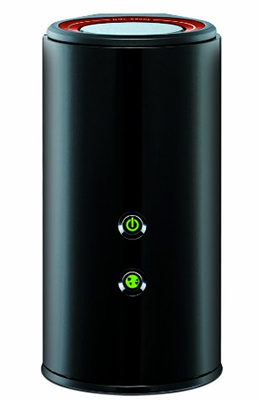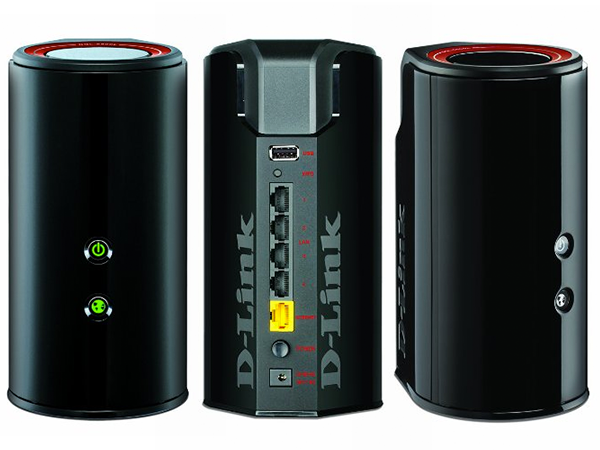Tom's Guide Verdict
The inexpensive D-Link DGL-5500 looks cool and has powerful networking software, but it falls flat on speed and range.
Pros
- +
Innovative tower design
- +
No external antennas
- +
Inexpensive
- +
Useful software
Cons
- -
Disappointing range
- -
Low throughput
- -
No guest network option
Why you can trust Tom's Guide
If looks, price tag and software matter more than raw networking performance, D-Link's DGL-5500 router is for you. While it's aimed at gamers, it's a relative bargain for an 802.11ac router,at $125. Just don't expect much in the way of range.
Design
In a world dominated by rectangular routers with enough antennas to look like coat rack, the DGL-5500's sleek cylindrical tower goes against the grain. At 7.5 x 4.7 x 3.9 inches, it's nearly as compact as the TrendNet TEW-812DRU, which also lacks external antennas, but D-Link's design might be the first router you'd want to show off to friends.

Rather than looking like a Christmas tree with lots of lights, the DGL-5500 is minimalist, with two LEDs up front that show when the device is powered up and connected to the Internet. There's no switch to turn the lights off, but the router has a power switch in the back as well as a recessed reset button underneath for restoring the device's factory settings.
Simplicity is the watchword here, because the back of the DGL-5500 has 4-gigabit Ethernet ports, but it lacks teamed ports, such as those found on the ASUS RT-AC87U. These can take speed beyond gigabit-per-second performance. There's also a USB 2.0 port for a hard drive or printer, but the DGL-5500 lacks a faster USB 3.0 port like the one in the Trendnet TEW-812.
Setup
The DGL-5500's box contains a networking cable, AC adapter and quickie installation booklet. If you want the manual, you'll need to download it.
Once everything is plugged in, aim a browser window at "dlinkrouter.local" or the router's IP address (192.168.0.1) to start D-Link's Quick Setup Wizard. It starts by updating the router's software and then figures out your Internet connection and gives you the option of changing your security settings. Finally, you can set up the router's StreamBoost Quality of Service (QOS) system. In just a few minutes, I had a full Wi-Fi network up and running, with data flying back and forth.

Like many of its peers, the DGL-5500 comes from the factory with unique network names and passwords. Unlike any other, however, the details are not only on a printed label underneath the router on a card, but also on a sticker. My advice is to still change the name and password as soon as you can.
Get instant access to breaking news, the hottest reviews, great deals and helpful tips.
While the wizard will configure just about everything, you can also do it yourself using the router's WEP, WPA or WPA2 encryption. It has both Network Address Translation (NAT) and Stateful Packet Inspection (SPI) firewalls. The router, though, lacks the built-in virus protection that is included with the RT-AC87U.
In addition to running as a router, the DGL-5500 can be used as an access point or as a wireless bridge for extending a network. It can connect to clients manually or via the Wi-Fi Protected Setup (WPS) protocol. It works with a variety of devices, including iPads, Androids and PCs. While it can use a Radius server to authenticate clients, it won't work with an LDAP server.
StreamBoost Software
After logging into the DGL-5500, you have a good group of networking resources at your disposal. Click on MyNetwork to see a visual map of connected clients along with how much data is flowing into and out of each client, a nice touch that many others lack. On the left is a column of major configuration categories, but unlike the main screen for Netgear's Genie software, it doesn't prominently show the current firmware version.

You can test your Internet connection's speed, and the StreamBoost Quality of Service (QOS) system lets you fine-tune network performance based on type of data, client or the app it's using. The easiest way is to list the clients in order of data priority, which takes about a minute.

The router can work as a media server with a hard drive in its USB port. Unlike other routers, the DGL-5500 can't create a guest network that allows Internet browsing but blocks access to the network's drives. If you plan to have the posse over for a night of World of Warcraft, this might be a key gap in your network defenses.

As with the Trendnet TEW-812DRU, the DGL-5500 router has a cool software simulator that lets you try things out on-screen before making changes to the router's settings. It can be a vital safety net for those new to networking.
On the downside, the DGL-5500 can't use a 3G/4G USB dongle for emergency Internet access and isn't compatible with DD-WRT open-source firmware that can optimize and extend the router's features. This puts it a step or two behind state-of-the-art routers such as the ASUS RT-AC87U.
Performance
While Linksys and Netgear have embraced the tri-band approach to 802.11ac Wi-Fi, D-Link has concentrated on dual-band designs. The DGL-5500 has a 3X3 dual-band design with 2.4- and 5-GHz transmitters that can handle up to a theoretical peak of 1.3GHz, slightly lower than the TrendNet TEW-812's capacity of 1.75 GHz.
In throughput testing in an open area with ixChariot software, the DGL-5500 moved only 265.2 Mbps at 15 feet on the 5-GHz AC band. That's nearly 100 Mbps off the pace of the Trendnet TEW-812DRU (349.5 Mbps), and well below the average of 319.2 Mbps. At 140 feet, the D-Link's throughput of 150.3 Mbps was again less than the Trendnet (209.5 Mbps) and the average (216 Mbps).

In 2.4-GHz mode, the DGL-5500 moved 80.0 Mbps at 5 feet, which beat the group's average of 73.7 Mbps, but fell short of the TEW-812DRU's showing of 92.3 Mbps. In an older house with lots of walls and obstacles, D-Link's router had a range of only 135 feet, which was 15 feet short of the TEW-812DRU's 2.4GHz range of 150 feet.
MORE: Best All-in-One PCs
In more than a week of daily use, the DGL-5500 reliably doled out data for gaming and did well on our saturation test with four clients. While I watched a TV show on a Windows tablet and a movie on an Android phone, I listened to an Internet radio station on an iPad and moved data into and out of a networked drive with a desktop PC. None of the video streams froze or stuttered.
Warranty
D-Link stands by the DGL-5500 router with a two-year warranty that falls short of Trendnet's three years of coverage. Still, it's better than the year of coverage that most, including Linksys and Netgear, provide.
Bottom Line
While its easy-to-use QOS system and design make the D-Link DGL-5500 a router that you'd actually want to show off, its performance isn't nearly as attractive as its looks. For around the same price, the Trendnet TEW-812DRU has a more pedestrian look, but offers better range and throughput. Still, the D-Link's networking software makes it worth a second glance.
Follow us @Tom’s Guide on Facebook and Google+
Brian Nadel is a freelance writer and editor who specializes in technology reporting and reviewing. He works out of the suburban New York City area and has covered topics from nuclear power plants and Wi-Fi routers to cars and tablets. The former editor-in-chief of Mobile Computing and Communications, Nadel is the recipient of the TransPacific Writing Award.


